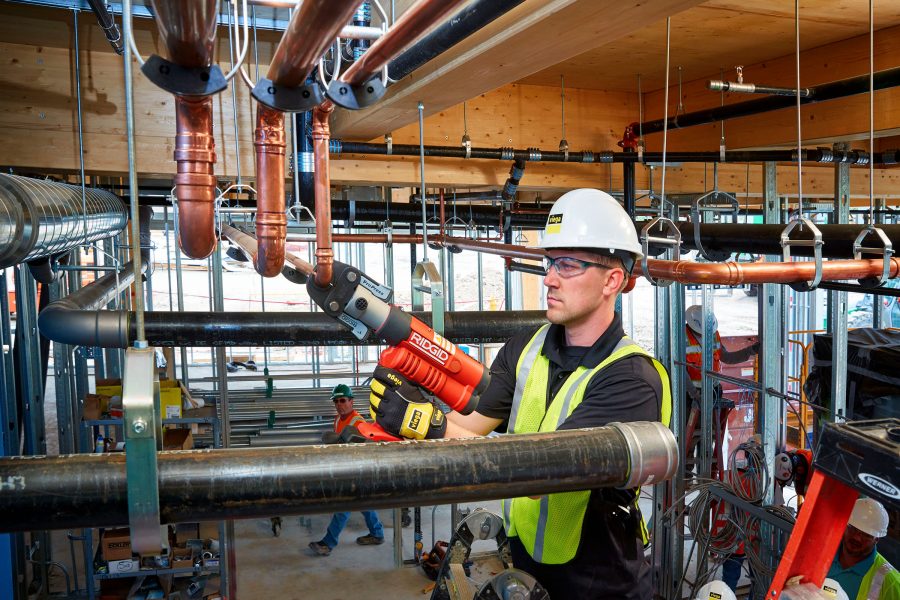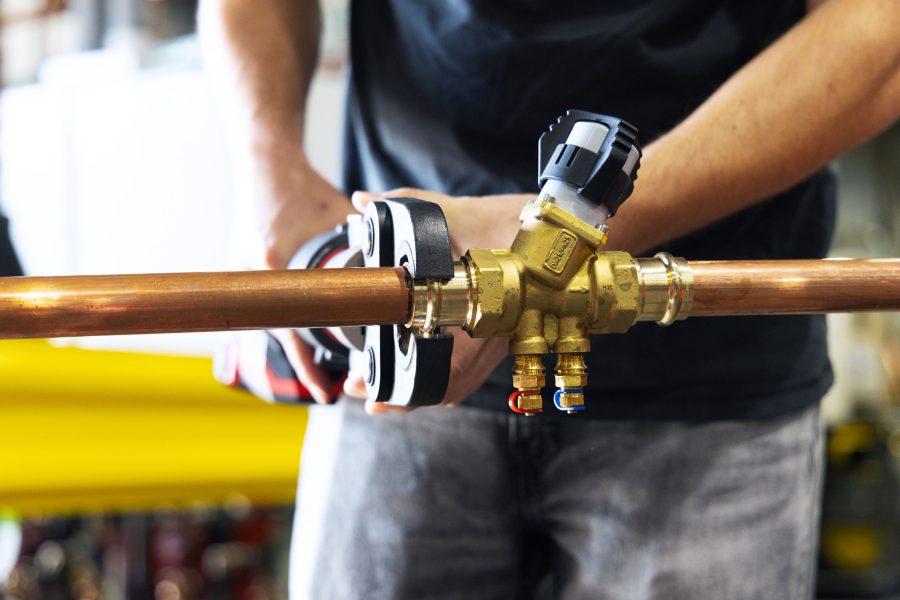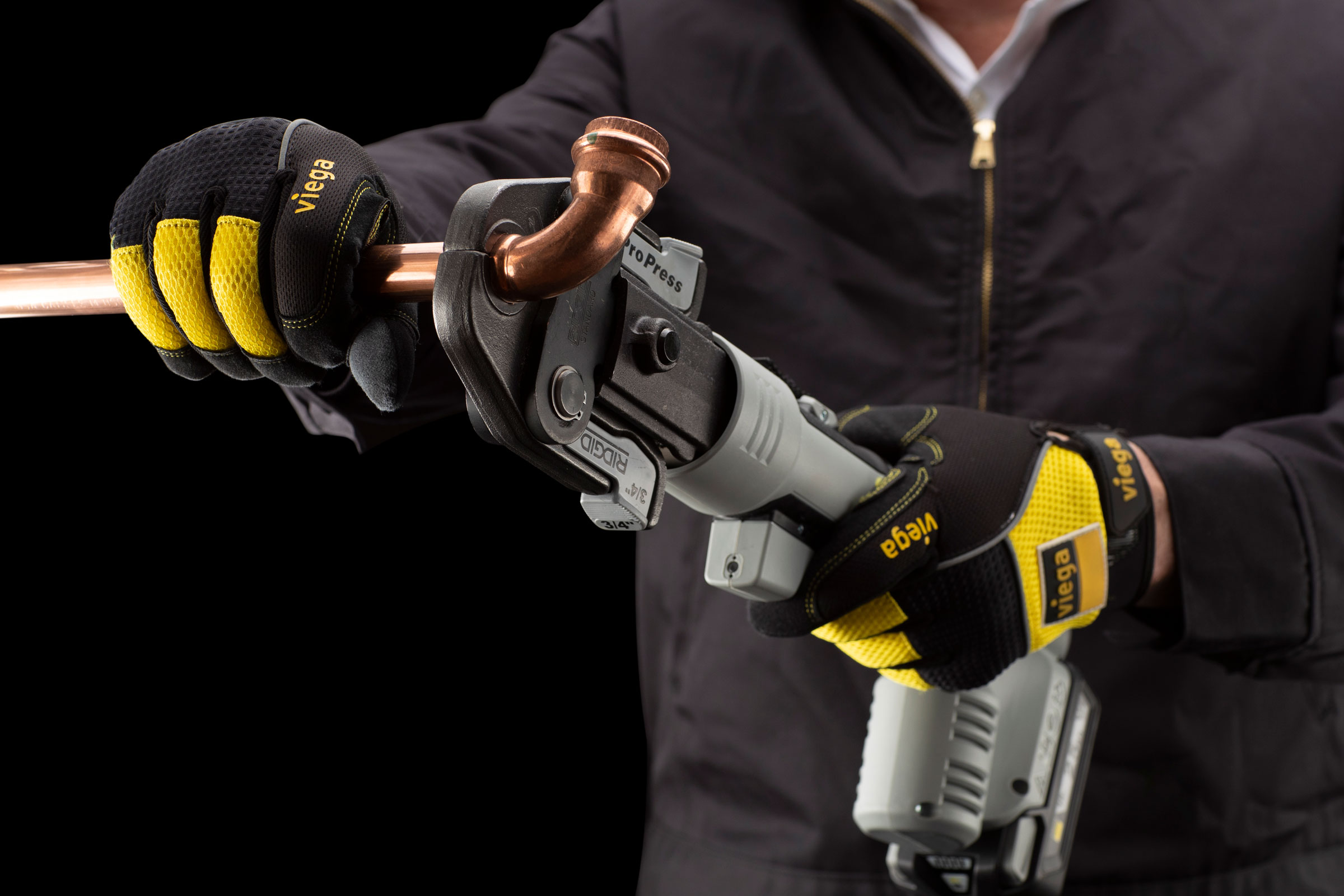Story at a glance:
- Experts share how press technology and what you choose for your pipe and fitting solutions can improve health care spaces.
- Modern press-connect systems offer a cleaner, faster, and more reliable alternative by using a hydraulic press tool to create a secure mechanical connection between pipes.
Health care facilities like hospitals and clinics are among the most complex structures to build and operate, given that they serve as critical infrastructure for some of our most vulnerable populations. Every piece of the project, from standard systems like plumbing, gas, and HVAC to the advanced medical technology that these buildings house, plays a vital role in patient safety and care.
“The difference is that the stakes are higher,” says Eric Olson, sales strategy manager at Viega, a leader in plumbing and piping technology. “The most critical need in health care is ensuring patient and staff safety. For a hospital, a single failure can have catastrophic consequences, which is why system reliability is non-negotiable.”
This is where innovative pipe and fitting solutions come into play, transforming health care facilities into truly healing environments. Today’s health care projects require plumbing, gas, and HVAC systems that not only function reliably but also improve air quality, safeguard water, reduce the risk of infection, and enhance sustainability.
Traditional Methods vs. Press Fitting Technology

Viega’s press fitting solutions are designed to be seamlessly integrated with other building systems. Their specialized press fittings and adapters enable reliable transitions between copper, PEX, iron, and stainless steel pipes. Photo courtesy of Viega North America
Traditional pipe fitting methods like soldering, welding, or brazing include the use of an open flame and can introduce contaminants into the pipe systems, lead to lengthy downtimes, and lack the precision needed for modern health care facilities. “Traditional methods add negative qualities to the piping system,” says Daniel Sabetta, technical sales manager at Viega. “You’ll have to do extra flushes to get rid of chemicals.”
Modern press-connect systems offer a cleaner, faster, and more reliable alternative by using a hydraulic press tool to create a secure mechanical connection between pipes. This is particularly important in the health care market, where repairs or system upgrades can have an impact on patients within the facility.
The Power of Integrated Systems

Viega’s ProPress can connect copper or stainless steel pipes in HVAC within minutes, reducing downtime and risk. Photo courtesy of Viega North America
Beyond the reliability of each individual component, health care projects increasingly depend on how well building systems work together. “Having all systems integrated is key, as they all affect the performance of the others,” says Rolando Conesa, principal at NELSON Worldwide, a national architecture and design firm.
Viega’s press fitting solutions are designed to be seamlessly integrated with other building systems. Their specialized press fittings and adapters enable reliable transitions between copper, PEX, iron, and stainless steel pipes. For example, Viega’s ProPress can connect copper or stainless steel pipes in HVAC within minutes, reducing downtime and risk.
These kinds of benefits matter to architects. “In a budget-driven world, facilities are looking to streamline operations, plan routine maintenance, and mitigate energy costs,” Conesa says. “Adaptable, energy-efficient systems and integrated building controls for smarter management are the future of health care facilities.”
Safety & Infection Control

Modern press-connect systems offer a cleaner, faster, and more reliable alternative by using a hydraulic press tool to create a secure mechanical connection between pipes. Photo courtesy of Viega North America
Few lessons from the Covid-19 pandemic were clearer than the importance of clean air and water as well as infection control. Those priorities now inform every health care project Conesa manages.
“In a post-Covid world containment and infection control are central to HVAC and plumbing design,” he says. “Every system in health care has to consider separating well people from sick people.” This requires sophisticated plumbing and HVAC systems with fully sealed connections that optimize control over flow, temperature, and filtration. Medical facilities in particular utilize specialized piping systems for unique applications not seen in the commercial, residential, or industrial markets, so the integrity of pipe connections is even more important.
Press systems also eliminate the need for flux and other additives that can harbor bacteria. “Legionella and things like that are always a big issue in hospitals, so the cleaner the system you can put in the better,” Sabetta says. “Viega has one of the cleanest solutions out there, especially for potable water lines.
Market Trends & Volatility
The market for health care facilities, like other areas of building construction and operations, is undergoing a transition as project teams balance performance with costs and labor shortages. Prefabrication and modular construction are one of the most important shifts in this regard. “We see a growing need for faster, more reliable installation methods to mitigate labor shortages,” Olson says. “Press solves that while speeding up the time to complete and commission a system.”
In a post-Covid world containment and infection control are central to HVAC and plumbing design.
To address the shortage of skilled workers, Viega maintains training programs for contractors and mechanical teams to familiarize them with their products. On one recent project—a 12-story hospital tower expansion in the eastern US—Viega hosted lunch-and-learns with the onsite mechanical and plumbing teams and provided them with a tour of their facilities in Germany to give them the assurances they needed to use ProPress for all domestic water lines and MegaPress gas for the cafeteria design.
Economic volatility is also pushing facilities to consider alternative materials. “This year has been very volatile,” Olson says. “That might shift the base material of the system from copper to plastics or stainless-steel options that provide some savings. Viega is able to offer a broader solution if or when systems are value-engineered to avoid cost.”
Building Code Updates
The growth in press connect solutions has also been driven by updates in building codes over the past five to 10 years. In the 2021 International Fuel Gas Code natural gas piping now allows for ANSI LC-4 / CSA 6.32 certified mechanical press-connect fittings to be used in indoor applications above 5 PSI.
“I believe the quality of Viega products is a large reason behind this change,” Sabetta says. “The MegaPress G fittings have been on the market for 13 years with great success, and building code decision-makers have taken notice and chosen to be more inclusive of those technologies due to their success on the market.”
Sustainability & Efficiency

A growth in press connect solutions has been driven in part by updates in building codes over the past five to 10 years. Photo courtesy of Viega North America
Sustainability is becoming increasingly important in health care settings for both environmental impact and operational efficiency. Pipe fitting solutions play a critical role in this by reducing energy consumption, water usage, and long-term maintenance needs by eliminating leaks through properly sealed pipe connections.
The installation process for press fitted solutions versus traditional methods also contributes to the sustainability of a project by lowering material use and energy consumption. “There are no chemicals or waste generated during the installation process,” Olson says. “No odors or flames are necessary to make the connection.”
Viega’s commitment to sustainability and transparency goes above the traditional industry standard through their use of Environmental Product Declarations (EPDs) for their solutions, which allow project teams and building owners to make informed decisions that support green building certifications. “Viega has very large sustainability aspirations,” Sabetta says. “We do have EPDs, which I believe is pretty rare in the plumbing fitting world. So that’s a pretty big step up, declaring all carbon emissions involved from the manufacturing to the transportation processes.”
Having highly efficient plumbing and HVAC systems is not only a great feature but also provides a financial benefit for developers and operators. “These systems are large upfront investments, but they pay themselves off,” Conesa says. “You can show a return on investment within five years through reductions in energy costs.”


